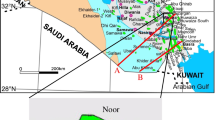Abstract
A suite of 27 oils from the Qinjiatun–Qikeshu oilfields in the Lishu Fault Depression of the Songliao Basin was analyzed using whole oil gas chromatography. In combination with the relative distribution of C27, C28, and C29 regular steranes, detailed geochemical analyses of light hydrocarbons in oil samples revealed crude oils characterized by the dual input of lower aquatic organisms and higher terrestrial plants. Several light hydrocarbon indicators suggest that the liquid hydrocarbons have maturities equivalent to vitrinite reflectances of around 0.78%–0.93%. This is consistent with the maturity determination of steranes C29 20S/(20S + 20R) and C29 ααβ/(ααα + αββ). Crude oils derived from the two distinct oilfields likely both have source rocks deposited in a lacustrine environment based on light hydrocarbon parameters and on higher molecular weight hydrocarbon parameters. The results show that light hydrocarbon data in crude oils can provide important information for understanding the geochemical characteristics of the Qinjiatun–Qikeshu oils during geologic evolution.
Similar content being viewed by others
References
Bement WO, Levey RA, Mango FD (1995) The temperature of oil generation as defined with C7 chemistry maturity parameter (2, 4-DMP/2, 3-DMP). Donostian-San Sebastian: European Association of Organic Geochemists, pp 505–507
Chen XH (2012) Study on the origin and accumulation of deep oil and gas in Lishu Fault Depression in Southern Song-Liao Basin. Department of Geochemistry of Yangtze University, Hubei (in Chinese with English abstract)
Cheng KM, Jin WM, He ZH, Cheng JP, Yang ZF (1987) Composition characteristics of light hydrocarbons in continental oil and condensate and their significance. Pet Explor Dev 14:34–43 (in Chinese with English abstract)
Dai JX (1993) Identification of coal formed gas and oil type gas by light hydrocarbons. Pet Explor Dev 20:26–32 (in Chinese with English abstract)
George SC, Boreham CJ, Minifie SA, Teerman SC (2002) The effect of minor to moderate biodegradation on C5 to C9 hydrocarbons in crude oils. Org Geochem 33:1293–1317
Hu TL, Ge B, Zhang Y (1990) The development and application of fingerprint parameters for hydrocarbons absorbed by source rocks and light hydrocarbon in natural gas. Pet Geol Exp 12:375–394 (in Chinese with English abstract)
Huang W, Meinschein WG (1979) Sterols as ecological indicators. Geochim Cosmochim Acta 43:739–745
Leythaeuser D, Pooch M, Schaefer RG (1983) Diffusion of light hydrocarbons on subsurface sedimentary rocks. AAPG Bull 67:889–892
Li HB, Zhang M, Chen XH (2013) Molecular geochemical characteristics of source rock in faulted lacustrine basin: a case study of the Lishu Fault Depression in southern Songliao Basin, China. Acta Geochimica 32:413–419
Mango FD (1987) An invariance in the isoheptanes of petroleum. Science 273:514–517
Mango FD (1990a) The origin of light cycloalkanes in petroleum. Geochim Cosmochim Acta 54:23–27
Mango FD (1990b) The origin of light hydrocarbons in petroleum: a kinetic test of steady state catalytic hypothesis. Geochim Cosmochim Acta 54:1315–1323
Mango FD (1994) The origin of light hydrocarbons in petroleum: ring preference in the closure of carbocyclic rings. Geochim Cosmochim Acta 58:895–901
Mango FD (1997) The light hydrocarbons in petroleum: a critical review. Org Geochem 26:417–440
Odden W (1999) A study of natural and artificially generated light hydrocarbons (C4–C13) in source rocks and petroleum fluids from offshore Mid-Norway and the Southernmost Norwegian and Danish Sectors. Mar Pet Geol 16:747–770
Peters KE, Walters CC, Moldowan JM (2005) The biomarker guide (volume 2): biomarkers and isotopes in petroleum systems and human history, 2nd edn. Cambridge University Press, Cambridge
Philippi CT (1975) The deep subsurface temperature controlled origin of the gaseous and gasoline-range hydrocarbons of petroleum. Geochim Cosmochim Acta 39:1353–1373
Schaefer RG, Leythaeuser D (1980) Analysis of trace amounts of hydrocarbons (C2–C8) from rock and crude oil samples and its application in petroleum geochemistry. Phys Chem Earth 12:149–156
Snowdon LR, Powell TG (1982) Immature oil and condensate-modification of hydrocarbon generation model for terrestrial organic matter. AAPG Bull 66:755–788
Thompson KFM (1979) Light hydrocarbon in subsurface sediments. Geochim Cosmochim Acta 43:657–672
Thompson KFM (1983) Classification and thermal history of petroleum based on light hydrocarbons. Geochim Cosmochim Acta 47:303–316
Thompson KFM (1987) Fractionated aromatic petroleum and the generation of gas-condensates. Org Geochem 11:577–590
Thompson KFM (1988) Gas-condensate migration and oil fractionation in deltaic systems. Mar Pet Geol 5:237–246
Zeng W, Liu H, Zhang M (2014) Geochemical characteristics and genetic types of crude oils from Qinjiatun and Qikeshu oilfields in the Lishu Fault Depression, Songliao Basin, northeastern China. Chin J Geochem 33:103–108
Zhang J (2010) Source rock evaluation of Yingcheng Formation from Lishu Fault Depression in South Part of Songliao Basin. J Oil Gas Technol 32:45–48 (in Chinese with English abstract)
Zhang M, Zhang J, Zhang CM (1999) Geochemical characteristics of light hydrocarbons for crude oils in Tarim Basin. Geochemistry 28:191–196 (in Chinese with English abstract)
Zhang M, Li HB, Wang X (2013a) Geochemical characteristics and grouping of the crude oils in the Lishu Fault Depression, Songliao basin, NE China. J Petrol Sci Eng 110:32–39
Zhang X, Song ZX, Xu W, Li ZB (2013b) Dynamic evaluation of oil-and-gas resources of Lishu Fault Depression in Songliao Basin. Pet Geol Exp 35:224–230
Acknowledgements
This study was financially supported by the National Oil and Gas Major Project (Grant No. 2016ZX05007001-002). We are grateful to the editor Binbin Wang and an anonymous reviewer for their helpful comments, suggestions and linguistic revisions of the manuscript.
Author information
Authors and Affiliations
Corresponding author
Rights and permissions
About this article
Cite this article
Li, J., Kong, T. & Zhang, M. Oil geochemistry derived from the Qinjiatun–Qikeshu oilfields: insight from light hydrocarbons. Acta Geochim 37, 433–440 (2018). https://doi.org/10.1007/s11631-017-0243-6
Received:
Revised:
Accepted:
Published:
Issue Date:
DOI: https://doi.org/10.1007/s11631-017-0243-6












